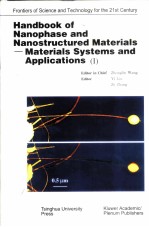图书介绍
纳米相和纳米结构材料应用 1 手册 英文版PDF|Epub|txt|kindle电子书版本网盘下载

- 王中林主编 著
- 出版社: 北京:清华大学出版社
- ISBN:7302057346
- 出版时间:2002
- 标注页数:397页
- 文件大小:35MB
- 文件页数:419页
- 主题词:
PDF下载
下载说明
纳米相和纳米结构材料应用 1 手册 英文版PDF格式电子书版下载
下载的文件为RAR压缩包。需要使用解压软件进行解压得到PDF格式图书。建议使用BT下载工具Free Download Manager进行下载,简称FDM(免费,没有广告,支持多平台)。本站资源全部打包为BT种子。所以需要使用专业的BT下载软件进行下载。如BitComet qBittorrent uTorrent等BT下载工具。迅雷目前由于本站不是热门资源。不推荐使用!后期资源热门了。安装了迅雷也可以迅雷进行下载!
(文件页数 要大于 标注页数,上中下等多册电子书除外)
注意:本站所有压缩包均有解压码: 点击下载压缩包解压工具
图书目录
1 Clusters1
1.1 Introduction1
1.2 Cluster Syntheses and Characterizations5
1.2.1 Sputtering/SIMS6
1.2.2 Supersonic Jet/Gas Condensation7
1.2.3 Laser Ablation and Vaporization9
1.2.4 Mass Spectrometers11
1.3 Stability and Magic Numbers16
1.3.1 Position Ordering and Momentum Ordering17
1.3.2 Inert Element Clusters——Mackay lcosahedron18
1.3.3 Alkali Halide Clusters22
1.3.4 Semiconductor Clusters24
1.3.5 Metal Clusters29
1.4 Physical Properties34
1.4.1 Size Effect of Electronic Properties34
1.4.2 Lattice Dynamics and Phase Change41
1.4.3 Optical Properties53
1.4.4 Magnetism58
1.4.5 Electronic Conductance67
1.5 Perspectives75
References76
2.1 Introduction85
2 Semiconductor Nanoparticles85
2.2 Synthesis of Semiconductor Nanoparticles86
2.3 Characterization89
2.3.1 Spectroscopy89
2.3.2 Microscopy90
2.3.3 X-ray Techniques91
2.4 Theory92
2.4.1 Quantum Size Confinement92
2.4.2 Ionization Potential and Coulomb Blockade96
2.5 Surface Modification97
2.5.1 Influence of Surface and Surface Modification97
2.5.2 Core/Shell and Coupled Semiconductor Nanoparticles99
2.6 Phase Transitions101
2.7 Nanocrystal Superlattices/Self-Assembly104
2.8 Applications106
2.9 Concluding Remarks108
References109
3 Electrochemical Self-Assembly of Ordered Quantum Dot and Wire Arrays121
3.1 Introduction121
3.2 Fabricating Quantum Dots:Self-Assembly122
3.3 Electrochemical Self-Assembly124
3.3.1 Self-Assembling a Mask for Qrdered Quantum Dot and Wire Arrays by Electropolishing Aluminum124
3.3.2 Theory of Pattern Formation during Electropolishing130
3.4 Quantum Dots Produced by Filling Nanopores in Anodic Alumina134
3.4.1 Theory of Pore Formation135
3.4.2 Filling the Pores by Electrodeposition136
3.5 Characterization of Quantum Dots Self-Assembled by Pore Filling138
3.5.1 Linear Optical Properties139
3.5.2 Non-linear Optical Properties141
3.5.3 Nanomagnetic Properties143
3.5.4 Electronic Bistability in Self-Assembled Quantum Dots and lts Circuit Applications144
3.6 Conclusion146
References146
4.1 Introduction to Nanowires150
4 Semiconductor Nanowires150
4.2 Methods of synthesis of the Nanowires151
4.2.1 Chemical Vapor Deposition(CVD)151
4.2.2 Laser Ablation152
4.2.3 Carbon Nanotube Confined Reaction153
4.2.4 Vapor Phase Evaporation155
4.2.5 Electrochemical Deposition—Template Approach157
4.3 Growth Mechanism of Nanowires159
4.3.1 Vapor-Liquid-Solid(VLS)Growth159
4.3.2 Solution-Liquid-Solid(SLS)Growth163
4.3.3 Vapor Phase Epitaxy163
4.4.1 Silicon and Germanium Nanowires165
4.4 Nanowire Systems165
4.4.2 Semiconductor Compound Nanowires179
4.4.3 Metal Nanowires186
4.4.4 Oxide Nanowires187
4.4.5 Other Nanowires197
4.5 Physical Property Study of the Nanowires198
4.5.1 Photoluminescence of the SiNW’s198
4.5.2 Raman Spectroscopy204
4.5.3 Nano-electronics208
4.6 Conclusion210
References210
5.1 Introduction215
5 Magnetic Nanocrystals and Arrays215
5.2 Theory217
5.3 Processing221
5.3.1 Lithography221
5.3.2 Atomic-Beam Holography224
5.3.3 Scanning Probe-Assisted Patterning224
5.3.4 Self-Assembling226
5.4 Characterization229
5.4.1 Physical Structure Characterzation229
5.4.2 Magnetic Structure231
5.4.3 Magnetic Measurements232
5.5.1 Effect of Particle Size on Magnetic Properties234
5.5 Properties,Applications and Materials234
5.5.2 Applications237
5.5.3 Materials Systems237
5.6 Concluding Remarks239
References240
6 Nanostructured Soft and Hard Magnetic Materials244
6.1 Introduction244
6.2 Nanostructured Soft Magnetic Materials245
6.2.1 Development of Soft Magnetic Materials245
6.2.2 Relationship between the Grain Size and the Coercivity247
6.2.3 Novel Nanostructured Soft Magnetic Materials249
6.3.1 History of Permanent Magnetic Materials251
6.3 Nanostructured Permanent Magnetic Materials251
6.3.2 Theoretical Outline of Exchange-Coupled Nanocomposite Magnets253
6.3.3 Preparation and Characterization of the Materials256
6.4 Nanomagnets263
6.5 Concluding Remarks264
References265
7 Nanomaterials for Information Storage269
7.1 Introduction269
7.2 Magnetic Recording Media270
7.2.1 Introduction270
7.2.2 Requirements for High-Density-Recording Media271
7.2.3 Structure and Magnetic Properties of Recording Media276
7.2.4 New Media Development285
7.3 Magnetic Recording Heads297
7.3.1 Introduction297
7.3.2 Materials Requirements for Recording Head Applications300
7.3.3 GMR Effect302
7.3.4 Exchange Coupling between Ferro-and Antiferromagnetic Films307
7.3.5 Magnetostriction315
7.3.6 Future Trends of Recording Head Research318
7.3.7 Perspective and Limitation of Magnetic Recording Technology319
7.4 Magnetic Random Access Memory320
7.4.1 Introduction320
7.4.3 Basic Principle of a PSV Cell321
7.4.2 MRAM Operations321
7.4.4 A Single-Domain Model for PSV Cell323
7.4.5 Micromagnetic Simulations326
7.4.6 Bit End Designs327
7.4.7 MRAM Materials328
7.4.8 A SDT Cell329
7.4.9 A Vertical GMR Cell330
7.4.10 Switching Speed331
7.4.11 Perspective332
References332
8.1 Introduction337
8 Magnetic Liquids337
8.2 Synthesis Processes338
8.2.1 Magnetic Particles338
8.2.2 Carrier Liquid and Surfactant340
8.3 Properties of Magnetic Liquids341
8.3.1 Stability of Magnetic Liquids341
8.3.2 Magnetic Properties344
8.3.3 Ferrohydrodynamics346
8.3.4 Optical Properties348
8.3.5 Ultrasonic Properties352
8.4 Applications353
8.4.1 Dynamic Process Seal354
8.4.2 Magnetic Liquid Film Bearing356
8.4.3 Magnetic Liquid Separators357
8.4.4 Magnetic Liquid Damper358
8.4.5 Magnetic Liquid Loudspeaker360
8.4.6 Magnetic Liquid Switch361
8.4.7 Magnetic Liquid Grinding362
8.4.8 Magnetic Liquid Sensors363
8.4.9 Magnetic Liquid Printing365
8.4.10 Biological and Medical Applications365
8.4.11 Other Applications367
8.5 Prospects368
References369
9 Functional Oxide Nanocrystals374
9.1 Introduction374
9.2 Transition and Rare Earth Metal Oxides374
9.3 Properties and Devices376
9.3.1 Sensoring377
9.3.2 Catalysis379
9.3.3 Actuating379
9.4 Silicates380
9.5 Nanocomposites381
9.6.1 Surface Atom Mobility and surface Reactivity382
9.6 Special Effects of Nanosize Oxides382
9.6.2 From Nanosize Crystals to Nanostructured Materials384
9.7 Self-Assembly of Oxide Nanocrystals385
9.7.1 Nanoparticles and Clusters385
9.7.2 From Nanocrystals to Films386
9.8 Meso-and Macroporous Oxides388
9.8.1 Structural Cavity389
9.8.2 Texture Porosity391
9.9 Biomimetic Mineralization392
9.10 Conclusion393
References394
Index396